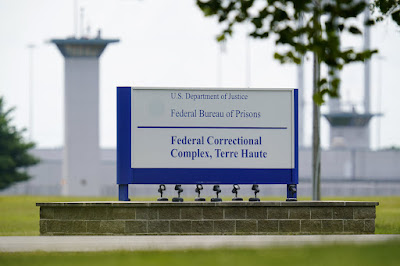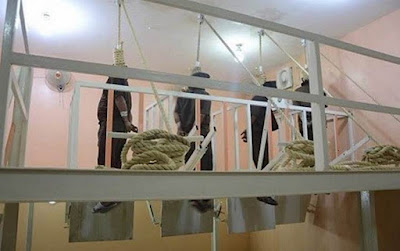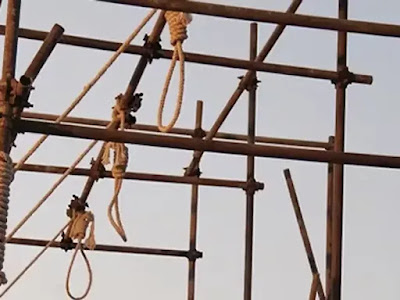The execution of
Louis XVI, in application of the death sentence of the former king of France and Navarre and former king of the French pronounced by the Members of the National Convention at the end of his trial, took place on Monday 21 January 1793 at 10:22 a.m., in Paris, on the Place de la Révolution (former Place Louis XV, which became
Place de la Concorde in 1795). It is a major event in the French Revolution, and more generally in French history.
Context
Following the events of August 10, 1792, the attack on the
Tuileries Palace by the Parisian sections and the republican federates supervised by the Jacobins, Louis XVI was imprisoned in the Temple Tower with his wife Marie-Antoinette and their two children, as well as his younger sister Princess Elisabeth. He lost his title of King of the French on September 21, 1792 following the abolition of the monarchy.
Accused of high treason, Louis XVI was condemned to death by a majority during the final vote on the sentence, beginning on January 16, 1793 and ending on January 17, 1793, after thirty-seven hours of debate without stopping.
The same evening, one of the fallen king's three lawyers, Guillaume de Malesherbes, came to the Temple to inform him of the verdict. He wrote to the future Louis XVIII, brother of the former king, on March 10, 1793, expressing his admiration for the composure of the deposed king and the feelings he had expressed during this interview.
Schedule of the evening of January 20
After voting to sentence the former king to death, the Convention sent a delegation to announce the verdict to Louis XVI, who was being held prisoner at the House of the Temple. He made a certain number of requests, including the granting of an additional period of three days before the execution itself, and a final meeting with his family. The Members of the Convention having refused to postpone the date of the execution of the former monarch, he will be guillotined as agreed the next day.
The condemned man's last dinner was served to him around 7 p.m. After having had a first meeting with the Abbot of Firmont around 8 p.m., Louis XVI received, as he had requested, the former royal family in his apartment, namely Marie-Antoinette, accompanied by her daughter Marie-Thérèse de France known as Madame Royale, of the dauphin Louis-Charles and the sister of the deposed king, Élisabeth of France.
Around 11 p.m., the former royal family withdrew and Louis XVI spoke again with his confessor. He went to bed around half past midnight.
January 21: The Last Day
The Temple Tower
After a short night, Louis XVI was awakened at 5 a.m. by Cléry, his valet. Around 6 o'clock, Abbot Henri Essex Edgeworth de Firmont joined them, and celebrated the last mass of the fallen king, served by Cléry.
Louis XVI received viaticum (communion for the dying).
On the abbot's advice, Louis XVI avoided a final farewell scene with his family. The security system is important, especially since on the night of January 20 to 21, the assassination of Louis-Michel Lepeletier de Saint-Fargeau, a member of the Convention who voted for the death of the former king, took place.
At 7 a.m., Louis XVI confided his last wishes to the abbot. He gave Cléry his stamp with the arms of France for his son Louis-Charles and his wedding ring for his wife. He kept the coronation ring on his finger.
Louis XVI spoke one last time with his confessor. Around 8 a.m., he was interrupted by Antoine Joseph Santerre who commanded the national guards. He received a final blessing from the abbot, handed over his will to one of the municipal officers present and placed himself at the disposal of Santerre.
Journey from Temple Prison to Revolution Square
On the morning of January 21, the outside temperature was low: it was 3°C (37°F). A thick fog enveloped Paris. The mayor of Paris Nicolas Chambon ensured that the deposed king would not be taken in the cart of the condemned. Louis XVI took his place in the mayor's green car, with the abbot and two people from the militia sitting in front of them.
The car left the Temple around 9 a.m. to the sound of drums and trumpets. It turned into
rue du Temple, to join the
Grands Boulevards. Paris then had 80,000 armed men (Federates, National Guards, riflemen) occupying crossroads, squares and posted along the streets. Cannons were posted at each strategic location. The convoy was preceded by around 200 mounted gendarmes.
Parisians came in large numbers to witness the execution, both on the route and at the location of the guillotine.
In the Bonne-Nouvelle district, near
rue de Cléry, Baron de Batz, support of the former royal family who financed the flight from Varennes, summoned 300 royalists to try to get the deposed king to escape. The former monarch was to be hidden in a house belonging to the Count of Marsan, rue de Cléry. Baron de Batz rushed forward. Following the denunciation of his companions, only a few were able to come. Three were killed, but Baron de Batz managed to escape.
The procession led by Santerre continued its journey along the boulevards and rue de la Révolution (current
rue Royale). It arrived around 10:15 a.m. on the Place de la Révolution and stopped at the foot of the scaffold installed between the Champs-Élysées and the pedestal of the statue of Louis XV which has just been unbolted and located 2 meters high. Painted red, the scaffold was placed in the middle of an empty space surrounded by cannons and a troop of Federals, the people being kept at a distance.
Execution of Louis XVI
He was greeted by the executioner Charles-Henri Sanson when he got off the carriage, he took off his brown frock coat and his scarf and tie. At Sanson's request, he opened the collar of his shirt. Seeing that the executioner's assistant wanted to tie his hands, the deposed king refused, the Abbot of Firmont succeeded in convincing him to agree to have his hands tied behind his back with his own handkerchief; Sanson's assistant cuts his collar and cuts his hair. Accompanied by drum rolls, Louis XVI climbed the stairs and joined Sanson and his four assistants on the platform.
Louis XVI advanced on the left edge of the platform. He signaled the drummers to stop and declared: “I die innocent of all the crimes imputed to me. I forgive the perpetrators of my death. I pray to God that the blood you are going to spill never falls on France." He wanted to continue but Santerre ordered the drums to beat again to cover his voice. Some authors mention that the order was given by other protagonists: among the names cited, those of Dugazon, Beaufranchet d'Ayat or the Pierrard drummer. Historical legend generally attributes this act to Santerre, but he only transmitted the order from General Berruyer, second in command in Paris.
At 10:22 a.m. the executioner Charles-Henri Sanson activated the guillotine. Gros, an assistant of the executioner, seized the bloody head and showed it to the crowd. Some authors claim, on the contrary, that the head was held up by Henri Sanson, the executioner's son. Some Parisians shouted “Long live the Nation!” Long live the Republic ! Long live freedom !"
A few artillery salvos were fired and some people danced a farandole. Jacques Roux, commissioner of the Paris Commune, wrote the minutes of the execution.
According to his executioner, Louis declared during his installation on the scaffold: “People, I die innocent!", then to the executioner Sanson and his assistants “I die innocent of all the crimes laid to my charge; I pardon those who have occasioned my death; and I pray to God that the blood you are going to shed may never be visited on France.”
The writer and political essayist Louis-Sébastien Mercier recounted the execution of Louis XVI in these terms: "[...] Is this the same man that I see being pushed around by four executioner's servants, stripped shirtless by force, his voice choked by drums, strapped to a board, still struggling, and receiving the blow from the guillotine's blade so badly that he had not his collar but his occiput and jaw horribly cut?"
: Wikipedia, DPN staff, January 21, 2024
_____________________________________________________________________


.jpg)




.jpg)







